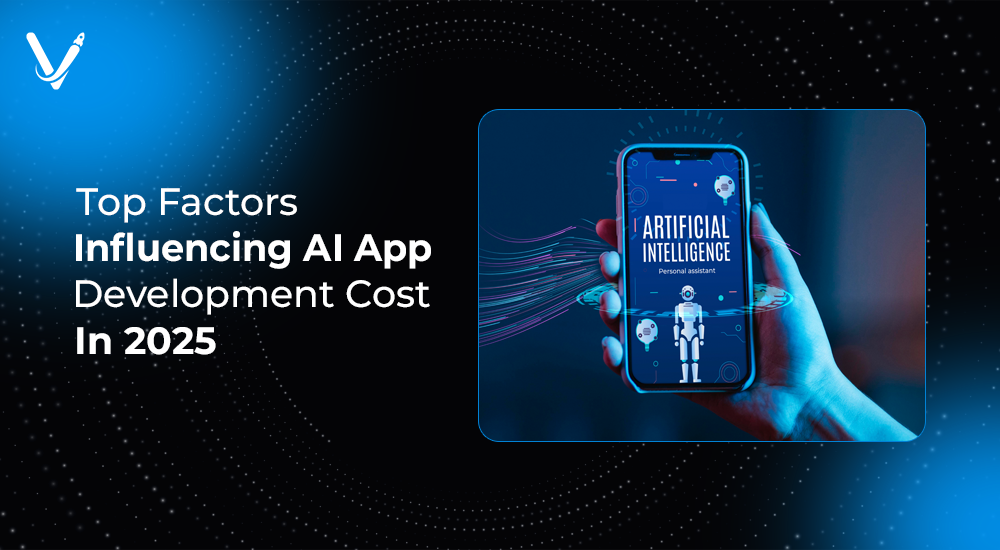Top Factors Influencing AI App Development Cost in 2025


- May 5, 2025
The demand for AI-powered applications continues to soar, reshaping industries and driving digital transformation. Businesses across the globe are eager to tap into AI's potential to enhance operations, customer experience, and innovation. However, understanding the cost structure behind AI app development is crucial for planning successful projects.
In 2025, multiple factors are poised to influence how much you need to invest in building an AI application. This guide explores the top elements affecting AI development costs, offers practical advice, and provides real-world examples to help you budget wisely and make informed decisions.
Artificial Intelligence is projected to reach a market value exceeding $500 billion by 2025, fueled by advancements in machine learning, natural language processing, computer vision, and robotics. Emerging trends like AI-as-a-Service (AIaaS), no-code AI platforms, and edge AI are reshaping how applications are built and deployed. Industry-specific AI adoption is growing rapidly, especially in healthcare, education, finance, logistics, and retail.
In addition, AI personalization is becoming a major driver for mobile applications. From personalized shopping experiences to adaptive learning platforms, AI's ability to customize services in real-time is pushing companies to rethink traditional app models. Tools like generative AI content creation, autonomous customer support, and AI-driven cybersecurity solutions are adding further complexity — and opportunity — to the AI app landscape.
While the proliferation of AI technologies democratizes access, it also introduces complexities that can significantly affect project budgets. Sophistication, scalability, regulatory compliance, and talent availability all contribute to rising costs. Businesses need to plan thoroughly, understand market demands, and anticipate future scaling requirements to manage costs effectively.
The nature of the AI solution being developed is the primary cost driver.
Categories Include:
Machine Learning Models: Supervised, unsupervised, reinforcement learning systems.
Natural Language Processing (NLP): Chatbots, sentiment analysis, language translation apps.C
omputer Vision: Facial recognition, object detection, medical imaging app
Predictive Analytics: Business intelligence and forecasting tools
Robotics and Automation: Autonomous vehicles, industrial automation systems
Real-World Example:
Developing a custom AI-based fraud detection system will generally cost more than deploying an AI chatbot because it demands more complex data modeling, regulatory adherence, and real-time learning capabilities.
AI applications vary dramatically in complexity. Simple rule-based chatbots can be built relatively quickly, while self-learning recommendation engines involve extensive data preprocessing, feature engineering, and model optimization.
Factors Increasing Complexity:
Actionable Tip:
Clearly define the project scope and start with a Minimum Viable Product (MVP) to control initial costs and expand functionality iteratively. Avoid the temptation to over-engineer in the first phase.
Data is the lifeblood of any AI application. The quantity, quality, and accessibility of data directly impact costs.
Cost Components Include
Case Study:
A healthcare AI company spent 40% of its initial project budget on anonymizing, cleaning, and labeling medical imaging data before model training could even begin. This upfront data effort was critical to achieving accurate diagnostic predictions later.
Actionable Tip:
Leverage pre-existing datasets where possible and invest early in building robust data pipelines. Automate data cleaning workflows to save time and resources.
The talent behind the project significantly affects both costs and outcomes.
Options Include:
Cost Variations:
Hiring AI engineers in the U.S. can cost $100–200/hour
Offshore developers may charge $30–60/hour, but additional communication and management overheads may arise.
Actionable Tip:
Choose a team with proven experience in your specific AI domain and consider hybrid models (local + offshore) for cost optimization. Prioritize teams with successful case studies in similar industries.
The tools and technologies you choose play a major role in budgeting.
Key Elements:
Real-World Example:
Training a large NLP model like GPT-3 on AWS can cost tens of thousands of dollars in cloud compute fees alone. Even hosting inference endpoints can rack up thousands per month depending on query volume.
Actionable Tip:
Optimize model size and architecture early to avoid skyrocketing cloud costs. Evaluate serverless options where appropriate for cost-efficient scaling.
Seamlessly integrating AI with existing applications, CRMs, ERPs, or IoT networks can be challenging and costly.
Factors That Increase Integration Costs:
Actionable Tip:
Conduct a thorough system audit before starting development to identify potential bottlenecks and hidden costs. Plan for fallback mechanisms if real-time integration is required.
Compliance requirements are growing stricter in 2025, especially around AI ethics, data privacy, and explainability.
Key Regulations:
Cost Implications:
Actionable Tip:
Factor compliance measures into the initial design to avoid costly retrofits later. Include budget lines for regular audits and updates as regulations evolve.
AI applications require continuous updates to stay effective and accurate.
Cost Range:
Maintenance can cost between 15–30% of the initial development cost annually.
Actionable Tip:
Budget for long-term maintenance right at the project planning stage. Establish clear ownership for post-deployment monitoring.
User experience design becomes more challenging when AI-driven outcomes must be presented clearly and intuitively.
Factors Affecting Costs:
Real-World Example:
An AI-driven financial app spent 25% of its total budget crafting explainable UX elements like confidence scores, recommendation rationales, and opt-out options.
Actionable Tip:
Invest in AI-specialized UX designers to improve adoption and usability. Communicate uncertainty gracefully through design.
Tight deadlines can escalate costs due to increased resource allocation, overtime, and expedited services.
Actionable Tip:
Plan development timelines realistically, balancing speed with quality to avoid technical debt and rework costs. Avoid compressing machine learning phases like data preparation and model validation.
If your app relies on third-party AI models, APIs, or datasets, licensing fees can add substantial hidden costs.
Examples:
Actionable Tip:
Assess the long-term licensing implications carefully during the planning phase. Look for open-source or commercially friendly licenses where possible.
Beyond the obvious expenses, hidden costs can significantly impact AI app budgets.
Retaining skilled AI talent over a long project can be challenging and costly. Competitive salaries, training allowances, and retention bonuses might become necessary to avoid turnover that delays development.
Cloud bills can spiral due to unnoticed compute spikes, unnecessary storage, or under-optimized inference serving. Regular audits and usage monitoring are essential to control cloud expenditure.
AI models, especially those in dynamic environments, need periodic retraining to maintain accuracy. This requires ongoing access to updated datasets, labeling efforts, and cloud compute for retraining sessions.
Component | Estimated % of Total Cost |
Data Collection & Preparation | 25% |
Model Development | 30% |
Infrastructure & Cloud Fees | 15% |
Integration & Deployment | 10% |
UI/UX Design | 10% |
Maintenance & Support | 10% |
Note: Actual percentages vary depending on project specifics.
A retail company decided to build an AI recommendation engine for their e-commerce platform. Two options were considered:
Option A: Build a custom model in-house
Estimated Cost: $350,000Timeline: 9 months
Option B: Integrate a third-party AI recommendation API
Estimated Cost: $120,000 (annual subscription)
Timeline: 2 months
Outcome:
The company chose Option B for rapid deployment but plans to invest in a custom model in the future to reduce long-term licensing cost
In 2025, developing an AI application is a strategic investment that demands careful planning and budgeting. Understanding the factors influencing costs — from data preparation to infrastructure choices, compliance obligations, integration challenges, and ongoing maintenance — enables businesses to navigate their AI journey more effectively.
The future promises even more complexity as AI becomes deeper embedded in critical industries. Being proactive about hidden costs, cloud management, and ongoing retraining will separate successful projects from costly mistakes.
Ready to turn your AI app vision into reality? Vasundhara Infotech offers tailored AI development services, ensuring innovation, efficiency, and cost-effectiveness. Contact us today to get started!
Copyright © 2025 Vasundhara Infotech. All Rights Reserved.
